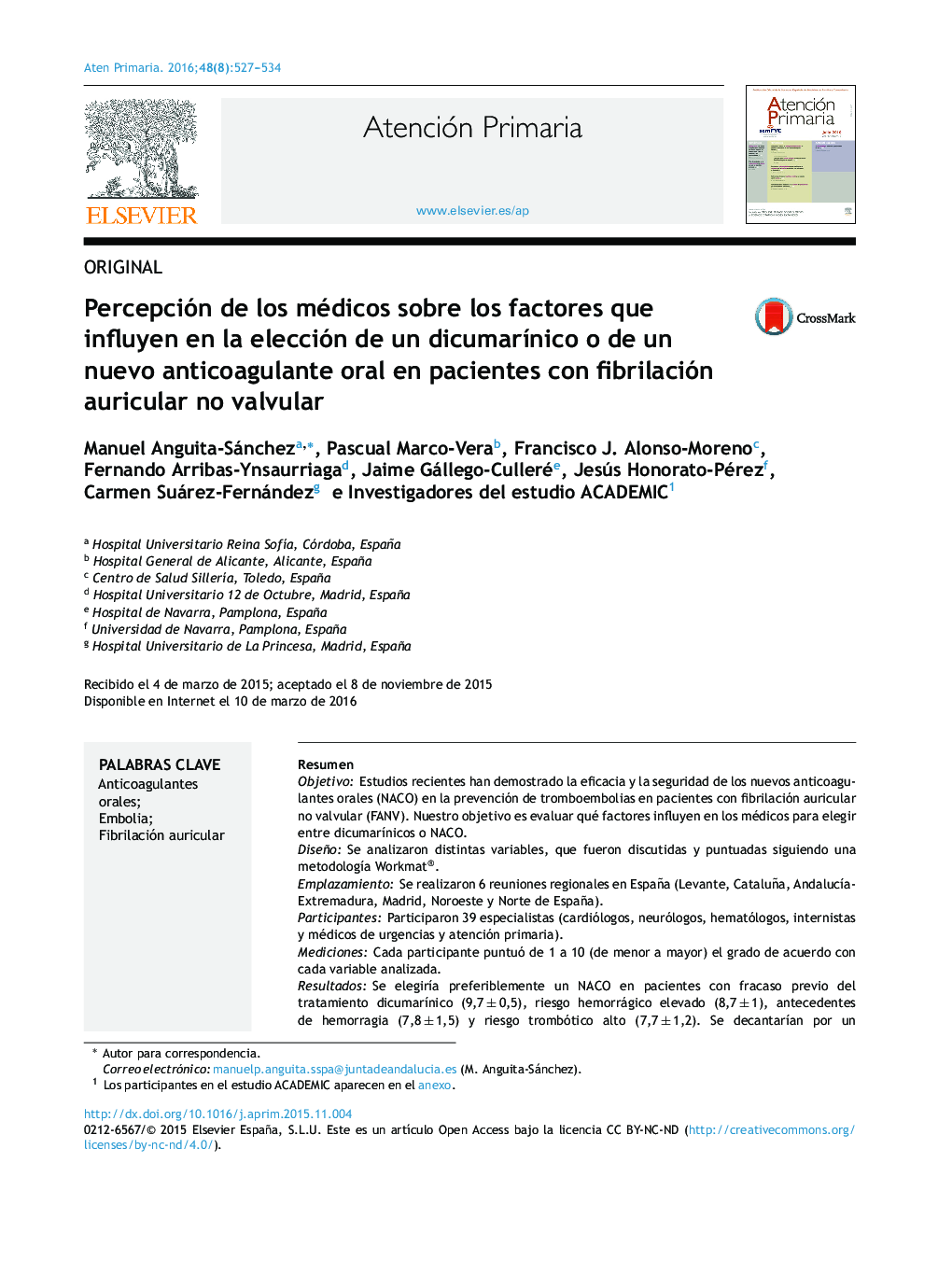| کد مقاله | کد نشریه | سال انتشار | مقاله انگلیسی | نسخه تمام متن |
|---|---|---|---|---|
| 5678111 | 1408572 | 2016 | 8 صفحه PDF | دانلود رایگان |

ResumenObjetivoEstudios recientes han demostrado la eficacia y la seguridad de los nuevos anticoagulantes orales (NACO) en la prevención de tromboembolias en pacientes con fibrilación auricular no valvular (FANV). Nuestro objetivo es evaluar qué factores influyen en los médicos para elegir entre dicumarÃnicos o NACO.DiseñoSe analizaron distintas variables, que fueron discutidas y puntuadas siguiendo una metodologÃa Workmat®.EmplazamientoSe realizaron 6 reuniones regionales en España (Levante, Cataluña, AndalucÃa-Extremadura, Madrid, Noroeste y Norte de España).ParticipantesParticiparon 39 especialistas (cardiólogos, neurólogos, hematólogos, internistas y médicos de urgencias y atención primaria).MedicionesCada participante puntuó de 1 a 10 (de menor a mayor) el grado de acuerdo con cada variable analizada.ResultadosSe elegirÃa preferiblemente un NACO en pacientes con fracaso previo del tratamiento dicumarÃnico (9,7 ± 0,5), riesgo hemorrágico elevado (8,7 ± 1), antecedentes de hemorragia (7,8 ± 1,5) y riesgo trombótico alto (7,7 ± 1,2). Se decantarÃan por un dicumarÃnico en casos de disfunción renal grave (1,2 ± 0,4) o moderada (4,2 ± 2,5), buen control con dicumarÃnicos (2,3 ± 1,5), deterioro cognitivo (3,2 ± 3) y riesgo hemorrágico bajo (4,3 ± 3). La edad, el sexo, el peso, el coste del fármaco, la polimedicación y la existencia de un riesgo trombótico bajo obtuvieron puntuaciones intermedias.ConclusionesEl riesgo trombótico y hemorrágico elevado y el fracaso del tratamiento previo con dicumarÃnicos predisponen a elegir un NACO. La insuficiencia renal, el deterioro cognitivo, el buen control con dicumarÃnicos y un riesgo hemorrágico bajo inclinan a decantarse por un dicumarÃnico clásico.
AimsRecent studies have demonstrated the efficacy and safety of new oral anticoagulant drugs for the prevention of thromboembolic events in patients with non-valvular atrial fibrillation. Our aim was to evaluate the factors that can influence physicians in their choice between a classic and a new anticoagulant in these patients.DesignSeveral variables of interest were discussed and analysed using a WorkmatTM methodology.SitesSix regional meetings were held in Spain (East, Catalonia, Andalusia-Extremadura, Madrid, North-east, and North of Spain).ParticipantsMeetings were attended by 39 specialists (cardiologists, neurologists, haematologists, internists, and emergency and Primary Care physicians).MeasurementsEach participant graded their level of agreement, with a score from 1 to 10, on every analysed variable.ResultsA new anticoagulant drug was preferred in patients with previous failure of dicoumarin therapy (9.7 ± 0.5), high haemorrhagic risk (8.7 ± 1), prior bleeding (7.8 ± 1.5), and high thrombotic risk (7.7 ± 1.2). Dicoumarins were preferred in cases of severe (1.2 ± 0.4) or moderate (4.2 ± 2.5) kidney failure, good control with dicoumarins (2.3 ± 1.5), cognitive impairment (3.2 ± 3), and low haemorrhagic risk (4.3 ± 3). Age, sex, weight, cost of drug, polymedication, and low thrombotic risk achieved intermediate scores. There were no differences between the different specialists or Spanish regions.ConclusionsThe presence of a high thrombotic or haemorrhagic risk and the failure of previous dicoumarin therapy lead to choosing a new oral anticoagulant in patients with non-valvular atrial fibrillation, while kidney failure, cognitive impairment, good control with dicoumarins, and a low bleeding risk predispose to selecting a classic dicoumarin anticoagulant.
Journal: Atención Primaria - Volume 48, Issue 8, October 2016, Pages 527-534